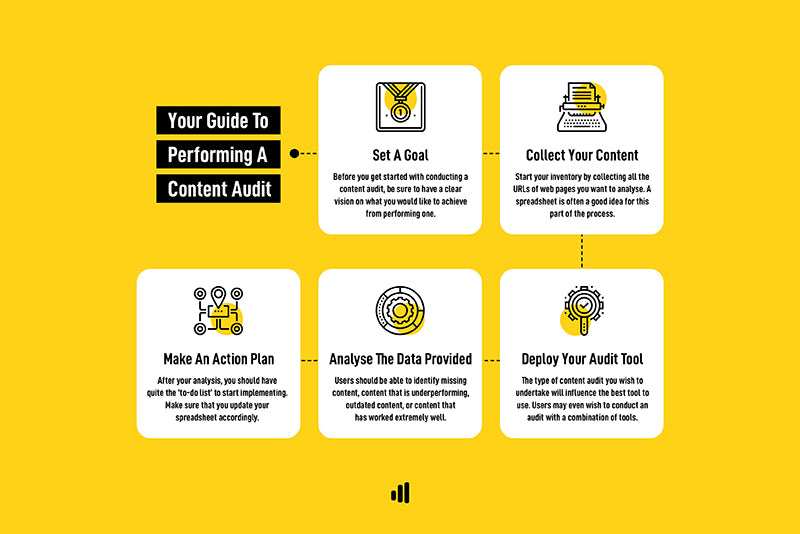If you’ve been busy blogging, it might be worth performing a content audit to determine what you’re doing well, and where you could potentially improve.
Content marketing is the term that applies to a type of marketing that involves the creation and distribution of online material, such as videos, blogs, and social media posts. Although it often does not explicitly promote a brand or business, content marketing is intended to stimulate interest in its products or services. While it is not the same thing as creating content for SEO purposes, some of the pillars do indeed overlap, and it can be used as a means to boost your brand’s visibility and presence on Google and other search engines.

For anyone trying to make their mark online, creating your own content is a non-negotiable. Depending on what type of content you’re producing and your level of experience, it can be tedious and time consuming. While you might be making the effort to say post a blog once a week, how often have you checked to see the results of said effort? If the answer is never, then you’re overdue for a content audit.
Your Guide To Performing A Content Audit
In simple terms, a content audit is the process of collecting and analysing your digital assets found on your website, such as landing pages or blog posts. The goal of a content audit is to provide insight into which types of content to create, update or even delete if necessary, along with identifying which content marketing strategies work well for your brand, and which don’t. Content audits can also provide technical insights into which parts of your website need your attention, such as missing metadata or broken links.
If this sounds like a task that could benefit you and your brand in the digital space, then the good news is undertaking a content audit is actually easier than most people would initially assume. While it might take a little bit of time and effort, the potential benefits make it worthwhile – so what does it involve?

Set A Goal – Before you get started with conducting a content audit, be sure to have a clear vision on what you would like to achieve from performing one. Clear and defined objectives often include a desire to improve your SEO score, boost conversion rates or increase your audience engagement levels. Once you have a goal in mind, this will allow you to set metrics to analyse the data accordingly.
Collect Your Content – Start your inventory by collecting all the URLs of web pages you want to analyse. A spreadsheet is often a good idea for this part of the process, as it allows users to both categorise by content type, date of publication, or even it’s stage in the buyer’s journey. Once you’re organised, a spreadsheet will also allow you to make notes on each piece of content, such as it’s overall score, or if it needs any updates.
Deploy Your Content Audit Tool – The type of content audit you wish to undertake will influence the best tool to use. For SEO crawls, try Semrush, Ahrefs or Screaming Frog. For Google based content analysis, try Analytics, Search Console and Page Speed Insights. There are also many others for overall quality control, such as Yoast SEO for WordPress. Users may even wish to conduct an audit with a combination of the above tools.
Analyse The Data Provided – By critically assessing the information your audit has provided, users should be able to identify missing content, content that is underperforming, outdated content, or content that has worked extremely well – and why. It will also help you to spot pages that are too slow to load, errors with optimisation, which keywords are booming for your website, along with any technical stuff like broken links.
Make An Action Plan – After your analysis, you should have quite the ‘to-do list’ to start implementing. Make sure that you update your spreadsheet accordingly, and allocate each link or piece of content with notes or categories to slowly chip away at later. If you plan on ranking by priority or including a timeline for this audit, now would be the time to include that too, as some tasks will be deemed more important or urgent than others.
While using content marketing as a means to improve your brand’s SEO is a no brainer, sometimes business owners simply don’t have the time, energy, experience or resources to do so. Instead of giving into the temptation of skipping this all together, it might be time to consider outsourcing to a reputable provider who can action this for you in a manner that is engaging, efficient and of course, optimised.
The Key To Good SEO Is Great Content
Producing quality, consistent and on brand content that’s SEO and ultimately Google friendly takes time, effort, experience and resources – and you’re not alone if you can’t quite commit to that. Avoiding the use of content marketing altogether may actually be doing your brand a disservice, but thankfully – investing in a solid strategy has never been easier.
Here at Content Hive, producing top quality digital content is exactly what we do best. We have itemised a list of digital content services, and allocated credits next to each of these. This means that each month, you can use your credits with us to produce digital content such as social media posts, blog articles, videos and even animated Instagram stories.
We believe that this model means we can produce high quality content in faster than normal delivery times. It also means that because you have a monthly credit, you are going to want to make sure you use these up – and so do we – meaning that your digital content is always consistent.
If you aren’t quite sure where to start on your digital marketing journey and would like to speak to a professional, why not book a free discovery call with us at Content Hive today to discuss how we can get your brand buzzing online.


